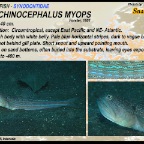Lizardfish - Synodontidae
LIZARDFISH - SYNODONTIDAE
There are around fifty different species of lizard fish. They have a long and slender body which they use to glide quickly through the water. These fish are not distance swimmers and rely on camouflage. Lizardfish have a large mouth and long teeth. Whilst resting on their pelvic fins, they wait motionless until their prey passes before attacking. Sometimes they catch big fish but because of the size, they have to let go. Length: 40 cm.Distribution: Circumtropical, except East Pacific and NE- Atlantic.Brownish body with white belly. Pale blue horizontal stripes, dark to vague bars.Black spot behind gill plate. Short snout and upward pointing mouth.Solitary, on sand bottoms, often buried into the substrate, leaving eyes exposed.From -3 to -400 m. Length: 20 cm.Distribution: Red Sea & E- Africa to SW- Japan, Hawaii, Marquesas Is. and Australia. Brown-grey mottled pattern, six saddles across back. Eigth to nine flower-shaped spots with pale centre on sides. Grey-blue stripe from head to tail. Red eyes. Often burried in sand with only eyes and nostrils exposed.On sand or rubble of sheltered and exposed reefs, from -1 to -70 m. Length: 32 cm.Distribution: R. Sea & E- Africa to SW- Japan, Hawaii, Fr. Polynesia, G.B.R, Lord Howe. Pale brownish body colour with dark brown to black blotches. Broad black band at first and second dorsal fin. Dark patches in mouth and on chin. Lives on sand or rubble near rocks or coral. Common on sheltered sand and silty reefs, from 0 to -135 m. Length: 28 cm.Distribution: from the Red Sea to French Polynesia, Ryuk and Lord Howe.Colour variable, going from red to brown. Lateral band of blotches often prominent.Lives on hard surfaces of lagoons and seaward reefs, from -5 to -40 m. They have a big mouth with slender sharp teeth, even on the tongue. Often in pairs.Voracious predator of small fishes.
















